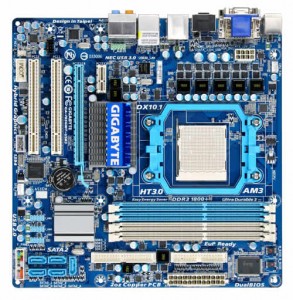Configuration Realized :
Carte mère : Gigabyte GA-785GMT-USB3 =80€
Compatible : CPU AM3 : AMD 785G + SB710 Chipset
RAM : 4Go DDR3 :KINGSTON DDR3 HyperX 2×2 Go PC3-12800 (1600MHz) = 108€
CPU :AMD Phenom II X4 965 Black Edition (Socket AM3) =169€
Disque Dur Hitachi 1 To = 70€
Carte Graphique : ATI HD RADEON 5450 1Gb DDR3 =50€ 
OS : UBUNTU 10.04 LTS
COOLER MASTER Elite 334 + Alimentation 460 W
^o^ Possible to realise Dual Screen ![]() 24″ + 19″ or more.
24″ + 19″ or more.
COOLER MASTER Elite 334 + Alimentation 460 W
TOTAL : 534€
I found around the same configuration at DEll store at around 749€ / 949€ .
- Other Advantages:
-Gobally the configuration doesn’t make any noise, I’ve choose the Fan Enermax.
-Quality of the component used in the motherborad & saving energy consumption
-Price
-USB 3.0
-Scapability of hardware configuration
- Disadvantage :
-Have some knowledge in Electronic to assemble the different components of the motherboard.
I strongly recommend to view the CPU LIST compabilty of the motherboe
Processor Support for AM3 processors: AMD Phenom™ II processor/ AMD Athlon™ II processor
Hyper Transport Bus 5200 MT/s
Chipset North Bridge: AMD 785G
South Bridge: AMD SB710
Memory 4 x 1.5V DDR3 DIMM sockets supporting up to 16 GB of system memory (Note 1)
Dual channel memory architecture
Support for DDR3 1800 (OC)/1666/1333/1066 MHz memory modules
Onboard Graphics Integrated in the North Bridge:
1 x D-Sub port
1 x DVI-D port (Note 2) (Note 3)
1 x HDMI port (Note 3)
Audio Realtek ALC889 codec
High Definition Audio
2/4/5.1/7.1-channel
Support for Dolby Home Theater
Support for S/PDIF In/Out
Support for CD In
LAN Realtek 8111D chip (10/100/1000 Mbit)
Expansion Slots 1 x PCI Express x16 slot, running at x16 (PCIEX16)
(The PCI Express x16 slot conforms to PCI Express 2.0 standard.)
1 x PCI Express x1 slot
2 x PCI slots
Storage Interface South Bridge:
1 x IDE connector supporting ATA-133/100/66/33 and up to 2 IDE devices
5 x SATA 3Gb/s connectors supporting up to 5 SATA 3Gb/s devices
1 x eSATA 3Gb/s port on the back panel supporting up to 1 SATA 3Gb/s device
Support for SATA RAID 0, RAID 1, RAID 10 and JBOD
iTE IT8720 chip:
1 x floppy disk drive connector supporting up to 1 floppy disk drive
USB South Bridge:
Up to 12 USB 2.0/1.1 ports (Note 4) (6 on the back panel, 6 via the USB brackets connected to the internal USB headers)
NEC D720200F1 chip:
Up to 2 USB3.0 ports on the back panel
IEEE 1394 T.I. TSB43AB23 chip:
Up to 2 IEEE 1394a ports (1 on the back panel, 1 via the IEEE 1394a bracket connected to the internal IEEE 1394a header)
Internal I/O Connectors 1 x 24-pin ATX main power connector
1 x 8-pin ATX 12V power connector
1 x floppy disk drive connector
1 x IDE connector
5 x SATA 3Gb/s connectors
1 x CPU fan header
1 x system fan header
1 x front panel header
1 x front panel audio header
1 x CD In connector
1 x S/PDIF In/Out header
3 x USB 2.0/1.1 headers
1 x IEEE 1394a header
1 x serial port header
1 x clearing CMOS jumper
Rear Panel I/O 1 x PS/2 keyboard port or PS/2 mouse port
1 x D-Sub port
1 x DVI-D port (Note 2)(Note 3)
1 x HDMI port (Note 3)
1 x optical S/PDIF Out connector
1 x eSATA 3Gb/s port
1 x IEEE 1394a port
4 x USB 2.0/1.1 ports
2 x USB 3.0/2.0 ports
1 x RJ-45 port
6 x audio jacks (Center/Subwoofer Speaker Out/Rear Speaker Out/Side Speaker Out/Line In/Line Out/Microphone)
I/O ITE IT8720 chip
H/W Monitoring System voltage detection
CPU/System temperature detection
CPU/System fan speed detection
CPU overheating warning
CPU/System/Power fan fail warning
CPU/System fan speed control (Note 5)
BIOS 2 x 8 Mbit flash
Use of licensed AWARD BIOS
Support for DualBIOS™
PnP 1.0a, DMI 2.0, SM BIOS 2.4, ACPI 1.0b
Unique Features Support for @BIOS
Support for Q-Flash
Support for Xpress BIOS Rescue
Support for Download Center
Support for Xpress Install
Support for Xpress Recovery2
Support for EasyTune (Note 6)
Support for Easy Energy Saver
Support for Time Repare
Support for Q-Share
Bundle Software Norton Internet Security (OEM version)
Operating System Support for Microsoft Windows 7/Vista/ XP
Form Factor Micro ATX Form Factor; 24.3cm x 24.3cm
Note (Note 1) Due to Windows Vista/XP 32-bit operating system limitation, when more than 4 GB of physical memory is installed, the actual memory size displayed will be less than 4 GB.
(Note 2) The DVI-D port does not support D-Sub connection by adapter.
(Note 3) Simultaneous output for DVI-D and HDMI is not supported.
(Note 4) Two share the same port with USB3.0.
(Note 5) Whether the CPU/system fan speed control function is supported will depend on the CPU/system cooler you install.
(Note 6) Available functions in EasyTune may differ by motherboard model.



![WorldCat lets people access the collections of libraries worldwide [WorldCat.org] WorldCat lets people access the collections of libraries worldwide [WorldCat.org]](http://www.worldcat.org/images/wc_badge_120x60.gif?ai=sungard_myartaud)